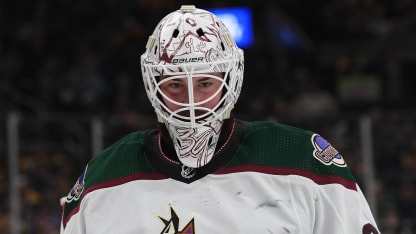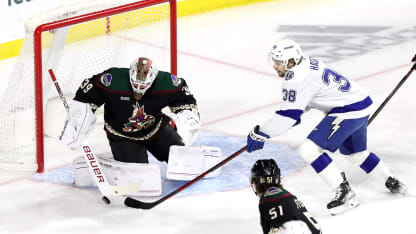But none of it was guaranteed. Not after he was late to the position, not becoming a full-time goalie until he was 13, not after he was traded on June 14, 2019 from the Tampa Bay Lightning to the Nashville Predators for a seventh-round pick in the 2021 NHL Draft, not after he was placed on waivers on Oct. 9, 2022, by the Predators.
Not after he entered the NHL/NHLPA player assistance program on Jan. 25, 2021.
Ingram had undiagnosed obsessive-compulsive disorder (OCD) that left him drinking too much, obsessed with the possibility of contamination, the reason he still shies away from high fives with fans he doesn’t know personally.
It’s something he can gently joke about now, even as he acknowledges it will be with him always. But then?
It nearly derailed everything.
* * * *
The Homewood Suites in Nashville had a built-in kitchenette, a full-sized fridge, a few touches to make life easier for someone on a long-term stay. And Ingram’s stay in 2020 and 2021 was extremely long term, 200-some days holed up by himself in a place that was never going to feel like home.
“Didn’t use it,” Ingram quipped of that fridge. “Of course not. But I had one.”
He laughs, first suggesting that the only thing in his fridge was ketchup, then admitting that he actually hates ketchup, that it makes him gag. He’s more of a ranch dressing guy.
That hotel had been his home for months and months and months, as the pandemic cut him off from so much, as it did for everyone. It was a difficult time, especially for those forced to be alone, especially for those whose time alone might lead them to spiral.
Like Ingram.
The Predators had brought the team back early before the bubble, went one-and-done in the bubble in Edmonton, losing in the Qualifying Round to the Coyotes, returned to Nashville, before Ingram went to Sweden where he played nine games for IF Bjorkloven of HockeyAllsvenskan, eventually returning to Nashville as part of the team’s taxi squad.
“It was transient. It was lonely,” he said. “No doubt about it. But I wasn’t the only guy in the League who went through that. Obviously, guys handled it better than I did.”
There had been signs of the OCD as far back as childhood, things that any parent would shrug off -- or even prize -- in a kid. Before he would go to bed, he would check to make sure his bike was put away, his baseball glove was in its spot, his wallet was where it should be.
It looked then like responsibility.
But there were other moments that had darker undertones, like the month-long projects he would be assigned at school that he would do start-to-finish in 72-hour stretches “because I couldn’t do anything else until I was done with it,” he said.
“They were like, great, you’re getting your schoolwork done, A-plus,” he said. “But then the older I got, it turned on me. Like, not everything was positive anymore.”
It manifested in multiple ways. He struggled with kids and their germs and stickiness, though his nieces and nephews don’t seem to trigger him. It’s the reason he still avoids those high fives.
There was also the deep fear of a sexually transmitted disease. He couldn’t get the possibility out of his head. And there, in that hotel room, with endless time to give in to his compulsions, he indulged a brain that was working against him.
“I thought I had AIDS all the time, or HIV,” Ingram said. “That was where mine came from. I had read if you have syphilis, you’ll get a rash on your hands and the bottom of your feet. So every 10 minutes I would take my socks off and look at my feet and be like, ‘I’m still OK.’
“So that’s, for me, what it was. You’re locked in a hotel by yourself for nine months of a year, just you and that.”
It’s easy to compare OCD to an addiction. And it’s not wrong.
“If you have an OCD compulsion, the more you do it, the more your brain wants to keep doing it to make yourself feel better,” Ingram said. “So when you’re by yourself like that and you have every opportunity to do it, it gets stronger and stronger and stronger. I would go to the rink and we would be on the ice for an hour and a half and I couldn’t do those things for an hour and a half, I couldn’t do it anymore. I’d be shaking.”
He would excuse himself to the bathroom where, in a shower of brief relief, he would go through his checks, make sure he wasn’t infected.
His anxiety gone, for the moment, he would feel a sense of completion.
Five minutes later he would need it again. Then four minutes. Then three. That’s how people end up washing their hands over and over until they bleed, their bodies and their brains unable to take even the most momentary of breaks.
That’s why the Homewood Suites were so bad for Ingram, because he didn’t have anyone or anything to get in his way.
“For me, that’s all it was,” Ingram said. “That’s all you did. You were in a hotel room and you’re at the rink. It had full control of me.”
* * * *
Ingram was in another hotel room, this one in Dallas, when it all came to a head. He missed the bus to American Airlines Center and, when he finally got there, Predators’ goalie coach Ben Vanderklok knew something was up. He approached Ingram.
The goalie told him they needed to talk.
“I laid it out on the line for him,” Ingram said. “I said, I don’t want to do this anymore.”
He explained what he had been going through and told Vanderklok that he just wanted to go home, back to the tiny town of Imperial, Saskatchewan, where he was raised. He felt done, with the Homewood Suites, with his compulsions, perhaps with hockey entirely.
He didn’t think there was any choice, suddenly finding himself being late -- something that’s out of character -- finding himself unable to function on the ice. He believed the only option was to go home and, as he put it, “call it.”
“He was like, well, if you’re going to go home, why don’t you go and get help?” Ingram said. “I didn’t know what he was talking about.”
And there is where he got lucky. Though the NHL/NHLPA player assistance program is only for NHL players, and at that point Ingram had yet to make his debut, the goalie was on the Predators taxi squad at the time. He qualified.
An hour later, he was on a plane to California.
Ingram hadn’t known that OCD was the problem. He hadn’t known what had taken hold of him, and he certainly hadn’t known how to curb the impulses. It wasn’t something he had ever heard discussed and, so, he thought only that he was crazy.
Therapy changed everything.
Once he entered in-patient treatment, he started to understand what was happening. They explained that he couldn’t give in to it at all times. It made sense to him. He went through extensive exposure therapy, going into public spaces and touching door handles, then having to just sit with it. He still does it now, testing himself to see how long he can go “before I freak out.”
He would record the gaps between his compulsions in a time-sheet diary, trying with all his might to extend the breaks, to get just a little bit more time between them, then just a bit more.
It’s something he continues to work on, something that will be with him always.
“You’ve got to put the work in to feel good,” Ingram said. “You know what sets you off or what makes you calm, whatever it may be. It’s like addiction. You know if you go anywhere near that, it’s going to cause you problems. So I stay away from anything that might cause me to have a flare-up or be anxious or anything like that. It’s just putting in work, going to therapy, taking care of yourself.
“It’s like a nagging injury. If you don’t take care of it, it’s going to get worse. For the rest of my life, I’ll sit in a stranger’s chair and tell them my problems once a week. It’s just a fact of my life.”
* * * *
If anyone understands what Ingram has gone through, it’s Colin Wilson.
The former Predators and Colorado Avalanche forward, a veteran of 632 NHL games, also struggled with both addiction and OCD, also turning to the NHL/NHLPA player assistance program for help. Wilson and Ingram remain in contact, helping each other through something that can be difficult to understand.
“The process is one of humility and also it can be quite debilitating,” Wilson said. “I tried to do it for a lot longer than I probably should have. It’s great Connor did it much earlier as well. But I think it just gets to a point where you recognize -- you try to plug along, put your nose down and just play through it like an injury. But especially with something like OCD, it just can be a pretty large weight on your life.”
Wilson, like Ingram, has been open about his experience with the program, praising it for the way in which it has helped players struggling with mental health.
And that openness, he believes, has aided others.
“The fact that I’ve spoken about it, Connor’s spoken about it and is open about it, I think it’s certainly changed,” Wilson said. “You see more and more guys entering the program and being willing to share that they have, so I think it’s changed quite a bit.”
It’s something that former Predators coach John Hynes, who now coaches the Minnesota Wild, has seen. He coached Ingram and forward Mark Borowiecki, who also struggled with OCD with the Predators.
“It’s OK. It’s OK to get help,” Hynes said. “And when you come back, you’re going to get help with us too. I think that’s not just in my experience, but I think around the League.”
Especially after what so many went through during the pandemic.
“You’re not alone,” Hynes said. “That’s part of it, is when they’re going through it, they have someone to reach out, how do I get help? Should I get help? And then I think the second part of that is after they do, that they’re really respected and welcomed back for going through the process and having the ability to make that choice is important. It’s important to recognize it.”
* * * *
After Ingram had returned, after he had been turned to in the playoffs for the Predators, starting three games in a four-game sweep by the Avalanche in the Western Conference First Round, Nashville had a decision to make the following season. The battle was between Connor Ingram and Kevin Lankinen.




















